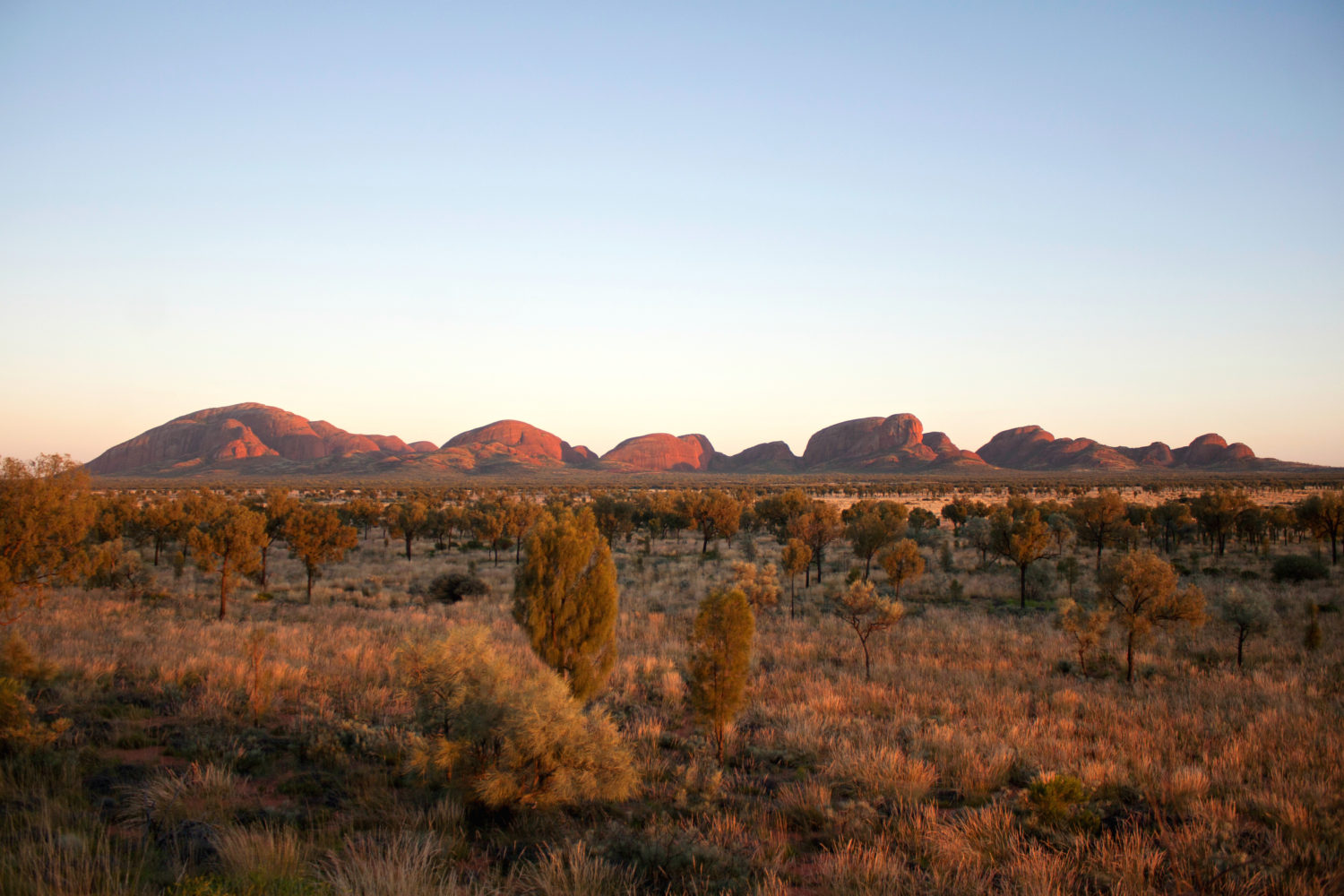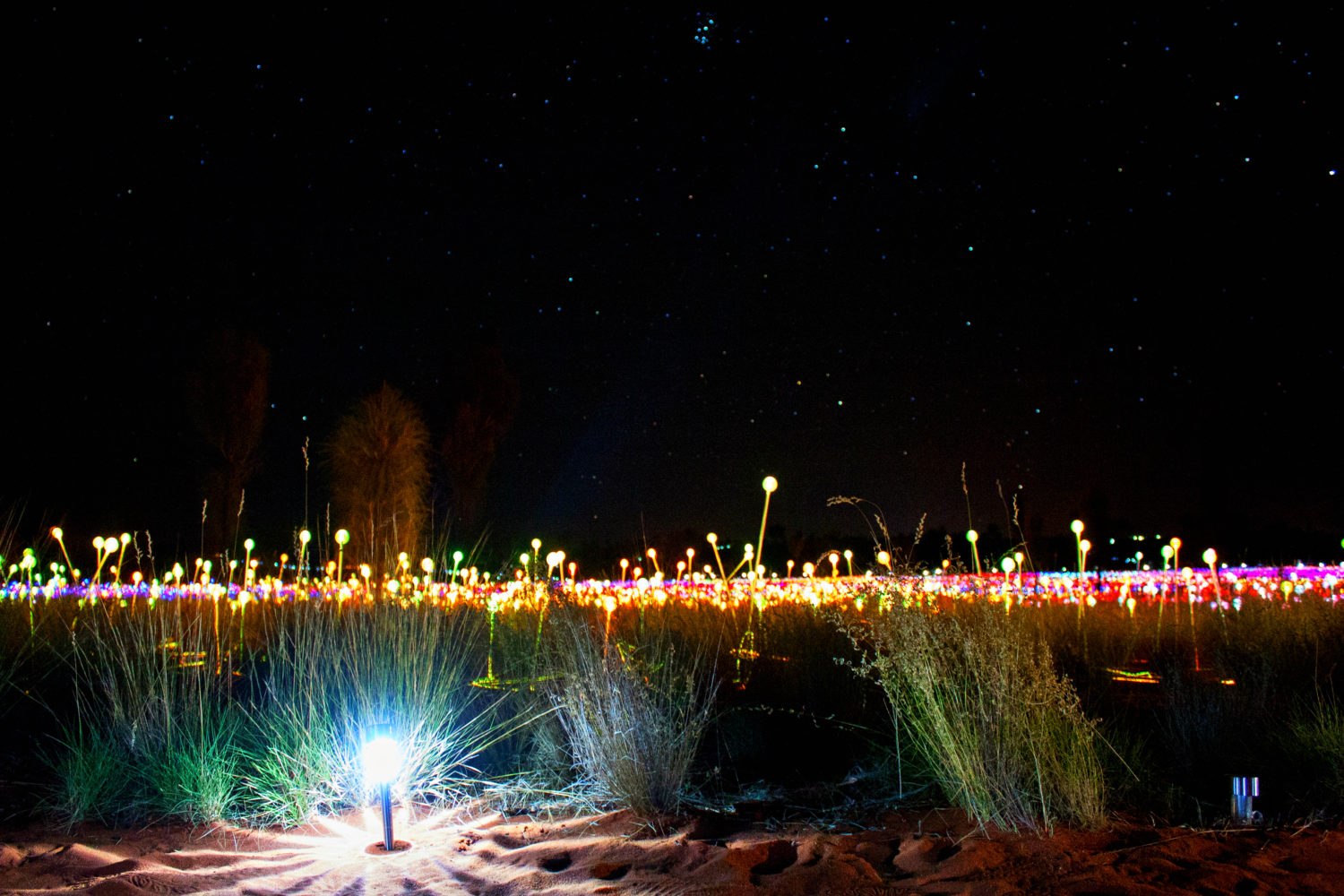Imagine: the vast, arid Australian outback in the depths of the night. The dusty red earth enveloped in the kind of darkness that makes it impossible to see your hand in front of your face, the only light coming from the shimmering pinpricks in the sky. Dingoes call off in the distance, the mosquitoes bite, and you wonder if you’re still on planet Earth.

Welcome to the “Red Center” of Australia, the extraordinary desert smack in the middle of the country, the ancient heart of the continent. It is the home of the traditional indigenous landowners, boasting some of the most spectacular sunrises and sunsets you’ll ever see, and Uluru, the sandstone monolith rising from the middle of the Northern Territory and a UNESCO World Heritage Site.
And just beyond Uluru itself is the incredible installation Field of Light, designed by internationally acclaimed artist Bruce Munro. As the light fades and Uluru’s silhouette is cast against the purple sky, the exhibition comes to life. In the local Pitjantjatjara language, it is called “Tili Wiru Tjuta Nyakutjaku,” or “looking at lots of beautiful lights.”
The installation’s shuttle bus picks up visitors at three different departure times throughout the evening, rumbling quietly through the remote desert landscape to the site. Upon arrival, the vastness of the pitch dark surrounding you feels almost stifling, as if the inky black sky couldn’t possibly get any blacker. Event guides greet you as you disembark from the bus, their stark flashlights feeling harsh amidst the natural landscape.
The group walks quietly through the bush until you start to see dots of glowing light ahead, as you quicken your pace to see more. Slowly, an anomaly amidst the dusty desert unfolds before you, and you have to stop to make sure you’re not imagining it. 50,000 solar powered globes come to light in a “garden” spanning the size of seven football fields. Their stems bend slightly in the hot night air, frosted spheres glowing blue, purple, ochre, and soft white as the sky above them darkens. Visitors stop to take photos before entering, the more advanced photographers setting up tripods and getting stunning time-lapse shots. It feels almost wrong to enter the installation; as if stepping inside might ruin the beauty of it all, and swallow you up whole.

Pathways draw visitors into the “fantasy garden” to explore at their own pace, guiding you along the winding paths through fields of psychedelic blooms. Shuttle buses depart the exhibition every two hours, giving visitors plenty of time to get lost amidst the lights. And lose yourself you will, as you wander further and further from the entrance deeper into the desert. Punctuated by small trees and benches for the occasional rest, the fields of solar powered globes feel almost trippy to gaze into. Before you know it, you’ve made your way back to the start, and will probably want to wander through again.
Field of Light is British artist Bruce Munro’s largest installation to date, and his first work that is entirely solar powered. “Field of Light was one idea that landed in my sketchbook and kept on nagging at me to be done,” he says. “I saw in my mind a landscape of illuminated stems that, like dormant seeds in a dry desert, quietly wait until darkness falls, under a blazing blanket of southern stars, to bloom with gentle rhythms of light”. He first conceived of the idea during a visit to Uluru in 1992, after living in Australia for eight years. His work uses light to evoke an emotional response, often in an outdoor setting and on a grand scale. Other “Field of Light” installations had taken place in England, the U.S.A., Scotland, and Mexico, before finally being created in Australia, the birthplace of its inspiration.
Once you’ve sufficiently wandered the exhibition and feel ready to drag yourself from its ethereal grip, make your way back to the shuttle bus location, taking in one last drink of the night sky sprinkled with stars—the kind you only see with the lack of light pollution that exists in the middle of a remote desert. Stepping into the cool air of the bus feels like a shock after the hot desert air, and the bus slowly fills with passengers similarly aglow in the aftermath of such an otherworldly experience.
Ayers Rock Resort, the host organization for the installation, offers a number of other Field of Light experiences as well, for those who want more than just a wander. The “Field of Light Star Pass” includes a panoramic view of the lights from atop a nearby dune, with an introduction to the exhibition before sunset, Outback-style appetizers, and drinks. “A Night at Field of Light” features the award-winning “Sounds of Silence” dinner, a three-course meal set under the desert sky while a resident “star talker” explains the southern night sky. Prefer the sunrise to sunset? Choose “Sunrise Field of Light” to explore the installation in the pre-dawn silence. Additionally, almost all of these options include an upgrade to the “Pass by Camel,” first bringing you to the Uluru Camel Farm where you can get a ride from a friendly camel to the installation. (Camels were originally brought to Australia in the 19th Century from Britain and Afghanistan to help with transportation and construction as western Australia was colonized, eventually being released into the wild after being replaced by motorized vehicles.) For those looking for a really mesmerizing Uluru experience, “A Night at Field of Light by Heli” offers the ultimate experience: installation entrance, “Sounds of Silence” dinner, and a half hour aerial helicopter tour.
No matter which ticket you choose, it’s important to note that Field of Light has been installed on indigenous land, and the Anangu people are the traditional owners and guardians of the National Park. (The land was handed back over to the Anangu people in 1985, and they then signed an agreement leasing the land to the Director of National Parks.) It is considered sacred to the traditional owners, and they invite visitors to hear stories of their ancient land—a visit to the Cultural Centre is free.
Field of Light has been extended until December 2020. Can’t make it to the middle of the desert in Australia? Well, this video is the next best thing:
Suggested next reading: Belgium’s Best Kept Secret Is Jaw-Droppingly Pretty

